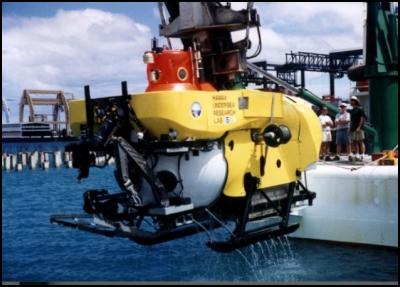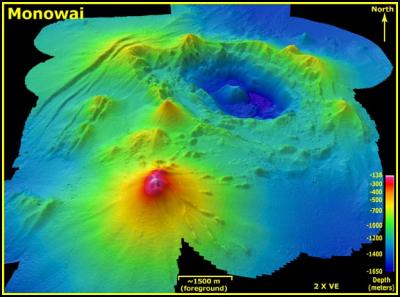Sub to explore New Zealand undersea volcanoes
MEDIA RELEASE
3 April 2005
Sub to explore New Zealand undersea volcanoes
New Zealand and American scientists have joined forces to explore some of the world's most active undersea volcanoes along the Kermadec Arc, northeast of the Bay of Plenty.
Using a submersible from the University of Hawaii, they plan to find out more about the nature and diversity of marine life that populates submarine volcanoes.
They are also aiming to gain new knowledge about the geology and chemistry of the seafloor and its ecosystems within New Zealand's Exclusive Economic Zone.
The scientists will dive on eight volcanoes, at least two of which are bigger than Mt Ruapehu and intensely active. They range in depth from 300m to 1800m.
The first leg of the 'New Zealand-American Submarine Ring of Fire 2005 Expedition' leaves Pago Pago, American Samoa, on 3 April and is expected to arrive in Tauranga on 22 April. Depending on the weather, the scientists hope to make 30 dives during the 70-day expedition.
" This will be the first intensive exploration of the chain of seafloor volcanoes in New Zealand's offshore territory. It will set the stage for future exploration of our Exclusive Economic Zone," said Dr Alexander Malahoff, chief executive of Geological and Nuclear Sciences Ltd (GNS).
Dr Malahoff, and Gary Massoth of GNS, will lead parts of the voyage with Dr Robert Embley of the US National Oceanic and Atmospheric Administration (NOAA).
Most of the target volcanoes have not been explored by submersible before. They were identified during previous New Zealand-American voyages on the National Institute of Water & Atmospheric Research (NIWA) deepwater research vessel, Tangaroa.
" If the weather and safety considerations permit, our first dives will probably be on the giant volcano, Monowai, which we discovered last year. Its caldera (crater) is as big as Wellington harbour, and eruptions have been recorded there as recently as the beginning of March," said Dr Ian Wright, of NIWA.
Each dive will last about eight hours with the submersible, Pisces V, carrying a crew of three - two pilots and a scientist.
Pisces V, capable of diving to a depth of 2km, is operated by the Hawaii Undersea Research Laboratory, and the expedition is using the University of Hawaii research vessel, Ka'imikai-o-Kanaloa, which will carry the submersible, personnel, and equipment. The expedition is funded by GNS, NIWA, and NOAA. In total, 20 scientists will participate in the voyage, from NOAA, GNS, NIWA, Oregon State University, and the University of Washington.
Regular updates of the project can be viewed at: http://oceanexplorer.noaa.gov/explorations/05fire
Offshore hotspots at a glance
Large submarine hotsprings within New Zealand’s EEZ represent a relatively new branch of science with numerous implications and benefits.

location map
Background
Offshore New Zealand has some of the most active and unusual submarine hot vents in the world. Scientists have mapped 77 submarine volcanoes in the 2500km stretch of seafloor between the Bay of Plenty and Tonga. Many host seafloor vents that produce large volumes of hot mineral-rich water and greenhouse gases such as methane and carbon dioxide. At some of these sites deposits of iron, manganese, copper, zinc, lead and even gold are forming continuously. Also at these sites are communities of unusual marine organisms thriving in hostile conditions. They are relatively new to science and knowledge of their biology and physiology may lead to significant advances in industries such as pharmaceuticals. The “black smoker” plumes produced by seafloor vents supply trace metals that are vital to the lifeblood of the oceans.

Pisces V submersible
Why do this research?
Associated with these seafloor vents are unusual ecosystems that are relatively new to science. A unique group of organisms thrive in this hostile environment ie under extreme pressure, in total darkness, next to very hot fluids (commonly between 300C and 350C). They live in a cocktail of chemicals that would be fatal to most life forms on the earth’s surface. They don’t need oxygen. They feed off carbon dioxide and hydrogen sulphide and excrete oxygen. Scientists believe these organisms may be similar to the earliest life forms on earth. Some of these organisms may have potential biochemical applications including advanced pharmaceuticals and anti-cancer agents.
Associated with the many seafloor hotsprings northeast of New Zealand are large mineral deposits consisting mostly of copper, lead, zinc, and some gold. – possibly in much greater concentrations than onshore New Zealand. They represent a strategic resource for New Zealand as they occur within New Zealand’s Exclusive Economic Zone and belong to the New Zealand Crown. Scientists believe it is important to know what seafloor resources lie within New Zealand’s EEZ so this offshore area can be managed prudently for future generations.
The New Zealand submarine hot spots, as well as being more active and in shallower water than equivalent vents elsewhere in the world, have a unique chemistry. Their plumes are richer in sulphur and iron than those observed elsewhere. Thus the term “black smoker”, as they spew out dark clouds of mineral-laden fluid.
The mineral-rich emissions from these vents may have an impact on the chemistry of the world’s oceans and may influence marine food chains. This is an active area of scientific research.
Improving our knowledge of submarine volcanoes and seafloor vents will help us better understand how the earth works and, in particular, how volcanoes and geothermal systems work.
New Zealand scientists are recognised internationally for their trailblazing work in investigating volcanic seafloor arcs. This has led to multiple collaborations in New Zealand and in other parts of the world.

Graphic of Monowai volcano


 NIWA: Flooding From Underneath - New Tool Reveals Shallow Groundwater Elevations
NIWA: Flooding From Underneath - New Tool Reveals Shallow Groundwater Elevations Commerce Commission: Commission Concludes Auckland Airport Over-charging By $190 Million
Commerce Commission: Commission Concludes Auckland Airport Over-charging By $190 Million The Future Is Rail: Ferry Decision - Common Sense Prevails
The Future Is Rail: Ferry Decision - Common Sense Prevails Aotearoa Food Rescue Alliance: Grocery Market Reform Must Include Mandatory Food Rescue Partnerships
Aotearoa Food Rescue Alliance: Grocery Market Reform Must Include Mandatory Food Rescue Partnerships Hugh Grant: Zero Trust Security - A Buzzword Or The Ultimate Protection?
Hugh Grant: Zero Trust Security - A Buzzword Or The Ultimate Protection? Bill Bennett: Comcom revisits fibre rules as competition intensifies
Bill Bennett: Comcom revisits fibre rules as competition intensifies



